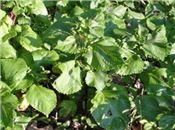|
Cattle Deaths Reflect Need To Control Toxic Pasture Weeds

The perilla mint has a broad, tooth-edged leaf.
University of Arkansas Division of Agriculture photo by Robert Seay
FAYETTEVILLE, ARK.
Washington County beef producers have been reporting cattle deaths from grazing perilla mint, a toxic weed common throughout Arkansas, said Berni Kurz, staff chair of the Washington County Cooperative Extension Office.
Kurz said perilla mint poisoning is suspected in several cattle deaths and has been confirmed in at least seven, including five reported by one producer last week.
Perilla mint typically grows in shady areas at the edges of fields, said John Jennings, University of Arkansas System Division of Agriculture professor of animal science and extension forage specialist.
“In rainy summers like we’ve had this year, perilla mint tends to spread out into the pastures, where it becomes more accessible to cattle,” Jennings said.
Kurz said ample rain this summer has resulted in considerable expansion of perilla mint into Washington County pastures and hardy growth.
“I’ve seen it 5 feet tall,” Kurz said. “Usually, it’s only about knee-high.”
Cattle usually find the weed unpalatable and avoid it, Jennings said. “They’ll even sort around it when it’s bound up in hay,” he said, though he noted that some animal deaths from eating perilla mint in hay were reported last year.
But when forage grasses become scarce, as when over-grazed or during drought, cattle will sometimes graze on perilla mint, Jennings said. Some cattle also have been reported eating the weed when it begins to wither, as during drought or when sprayed with herbicide.
Jennings said good general weed control is important, especially early in the season when plants are small, to protect cattle from perilla mint and other toxic weeds common in the state.
Other weeds in Arkansas that are toxic to grazing cattle include hemp dogbane, coffee senna, sesbania, and sicklepod.
Herbicide applications and bush-hogging can be used to clear toxic weeds from pastures, but Jennings cautions to keep cattle out of the field until the weeds are completely dead and fully withered. ∆
|
|